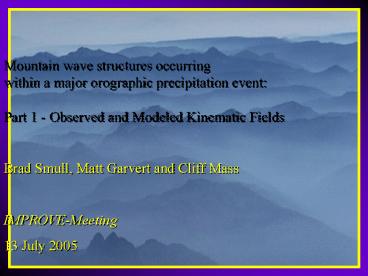Mountain wave structures occurring - PowerPoint PPT Presentation
Title:
Mountain wave structures occurring
Description:
Mountain wave structures occurring – PowerPoint PPT presentation
Number of Views:53
Avg rating:3.0/5.0
Title: Mountain wave structures occurring
1
Mountain wave structures occurring within a
major orographic precipitation event Part 1 -
Observed and Modeled Kinematic Fields Brad
Smull, Matt Garvert and Cliff Mass IMPROVE-Meetin
g 13 July 2005
2
Part-1 Discussion Topics
- Analysis capitalizing on fully 3-D kinematic
fields over complex terrain (unprecedented in
their detail) is made possible by airborne
Doppler radar observations spanning Cascade
crest, and reveals key features including - Sloped shear layer blanketing windward slopes
- Underlying stable, low-?e flow parallel to
barrier - Profound mountain-wave over mean crest
- Allows evaluation/verification of MM5 output
fields against the most spatially extensive
observational dataset available. - Model-based trajectory analysis illuminates
origins of windward shear-layer and contrasting
thermodynamic properties. - Sensitivity of shear layer and mountain wave
amplitude to PBL physics is evaluated via
multiple parameterizations available within MM5.
3
13 -14 December 2001 Case
- Strong frontal system impacted IMPROVE-2 study
area. - Event has been extensively studied (JAS Special
Issue). - PSU-NCAR MM5 v3.6 has been used to simulate the
event (Garvert et al. 2005a,b). - Here we focus on a two-hour period of relatively
steady airflow and precipitation structure from
2300-0100 UTC on 13-14 December 2001. - Highlight results from MM5 Control Run utilizing
MRF-type PBL parameterization. - All runs employ Reisner2? Thompson BMP scheme
180 W
160 W
140 W
120 W
100 W
60 N
50 N
40 N
IMPROVE-2 Study Area
30 N
500-hPa Heights and Temperature 0000 UTC 14
December 2001
4
IMPROVE-2 study area including terrain and P-3
track
Willamette Valley
Cascade Crest
Latitude (Deg)
SPL
IB
MB SBAND
MB
IB Profiler UW Sounding SPL Spol
Radar
UW
Distance from Crest (km)
Distance from Crest (km)
5
U- and V-wind profiles 120 km upstream of
Cascade crest (Irish Bend Profiler)
6
Radar reflectivity andwind vectors from
composite grid
Height 3 km MSL
7
Doppler-derived wind speed on composite grid at 3
km MSL
SPL
IB
Latitude (Deg)
MB
UW
Height 3 km MSL
Distance from Crest (km)
8
Observed Mean E-W Cross Section of U- and
V-component Flow and Mean Terrain
U-Wind
V-Wind
9
Analogous Mean Section of MM5-Simulated U and V
(2h temporal average from Control Run)
U-Wind
V-Wind
10
Corresponding MM5-Simulated Thermodynamics (?e)
U-Wind
V-Wind
Theta-e (K)
11
MM5 U-component flow pattern andsuperposed
trajectory endpoint locations
x
x
x
x
08-12
12-16
16-20
20-24
24-28
28-32
32-36
36-40
gt40
lt08
(m s-1)
U-Wind
Theta-e (K)
12
Contrasting sources of low- vs. mid-tropospheric
airstreams illustrated via MM5-based trajectory
analysis
2300
13
PBL Parameterizations
- Two basic approaches exist for evaluation of
- wa -?a da/dz
- First order closure ?a is specified from the
vertical shear and static stability - 1.5 order closure or TKE closure TKE is
predicted with a prognostic energy equation ?a
is specified using TKE and some appropriate
length scale. - Experience indicates that the PBL
parameterization can significantly impact the
structure and strength of mountain waves (Peng
and Thompson 2003)
14
Airborne Dual-Doppler Radar Observed Mean Cross-
and Along-Barrier Flow (for reference)
U-Wind
V-Wind
15
Horizontal Flow ?e from MM5 Control Run
Utilizing MRF-type PBL Closure
V-Wind
U-Wind
Theta-e (K)
16
MM5 Experimental Run Utilizing ETA-type
PBL(Mellor-Yamada 1.5 Closure)
U-Wind
V-Wind
Theta-e (K)
17
Corresponding Mean Vertical Motions fromMM5
Control Run Utilizing MRF-PBL
Theta-e (K)
18
ETA-PBL Experiment yields notable differences in
mountain wave behavior
Theta-e (K)
19
Impacts of PBL Parameterization Extend
toSimulated Precipitation Microphysics
Snow-diff
CLW-diff
Graupel-diff
Microphysics Differences ETA - MRF
20
Key Accomplishments and Conclusions
- 13-14 December IMPROVE-2 observational analysis
is likely the best in existence for
representation of airflow over complex terrain. - Provides unique context for BMP evaluation, and
unprecedented depiction of mountain wave
structure in a moist (saturated) environment. - Low ?e air banked up against Cascade foothills
acted as an effective barrier to higher ?e flow
coming more directly off Pacific, which
accelerated and ascended this effective barrier,
contributing to production of significant shear.
21
Conclusions (cont.)
- Strength of U-component (cross-barrier) shear is
underdone in MM5 control simulation (i.e., model
produces comparatively shallow and weak shear
layer over windward slopes). - Switch to ETL-type PBL yields notable
kinematic/microphysical changes, though not
necessarily improvements. - Intensity of mountain wave above mean crest is
very sensitive to the upstream shear and hence to
choice of model PBL parameterization.
22
Future Work
- Re-simulate this case with WRF to capitalize on
improved numerics/microphysics. - Examine additional events exhibiting similar
structures, e.g. IMPROVE-2 29-30 November event
and/or MAP IOP-8. - Further quantify sensitivity of simulated
flow/precip fields and underlying microphysical
processes to differing PBL parameterizations.
23
End
24
Observed Mean E-W Cross Section of U- and
V-component Flow
U-Wind
V-Wind
25
Corresponding Perturbation Flow Patterns
U
V
-13 -11
-15 -13
-11 - 9
- 9 - 7
- 7 - 5
- 5 - 3
- 3 - 1
- 1 1
1 3
3 5
5 7
7 9
gt 9
lt-15
(m s-1)

